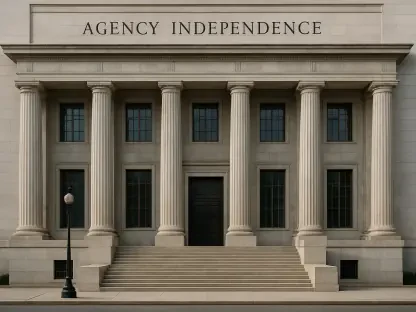On February 14, 2025, the National Labor Relations Board (NLRB) made a significant decision to rescind a series of enforcement guidance documents issued during the Biden administration, a move that sent ripples through labor relations circles across the country. The rescinded documents covered a wide range of topics within the NLRB’s jurisdiction, including memos on workplace surveillance, noncompete agreements, relief for employees, and the employment status of NCAA student athletes. The decision was underscored by Acting General Counsel William Cowen’s rationale that addressing the growing case backlog was of paramount importance to maintaining the NLRB’s functionality. This unexpected development prompts a discussion on what led to this reversal and what the future holds for labor relations under the NLRB’s evolving policy stance.
Addressing Workplace Surveillance and Noncompete Agreements
One of the significant memos affected by the rescission was a 2022 guideline issued by former General Counsel Jennifer Abruzzo, which delved into the intricate relationship between workplace surveillance programs, artificial intelligence tools, and workers’ rights under the National Labor Relations Act (NLRA). The memo raised red flags about potential interference by these technologies in employees’ rights, emphasizing the need for vigilant oversight to protect workers from any perceived or actual violations. Similarly, another crucial memo rescinded was Abruzzo’s 2022 guidance on noncompete agreements, which pointed out potential NLRA violations arising from restrictive covenants that hinder workers’ ability to seek new employment opportunities.
These memos were integral in shaping the NLRB’s stance on emerging issues in contemporary workplaces, especially in an era where technological advancements and evolving labor practices continuously challenge existing regulations. By rescinding these memos, the NLRB aims to reset its approach, potentially allowing room for reevaluation and possible updates that might better align with current labor market complexities. This act of rescinding also signifies a broader attempt to streamline the NLRB’s priorities in handling cases more efficiently in the face of an overwhelming backlog.
Impact on Student Athletes and Employer Bargaining Obligations
The rescission of memos wasn’t limited to surveillance and noncompete agreements; it also encompassed other contentious areas like the employment status of NCAA student athletes and employer obligations concerning union bargaining. Specifically, a 2021 memo, which declared that NCAA student athletes are considered employees under labor laws, was rescinded. This particular stance had opened doors for student athletes seeking better labor protections and increased the discourse around their rights and compensations. However, the rescission brings this debate back to the drawing board, leaving many stakeholders uncertain about the future trajectory of student athletes’ labor rights.
Additionally, a 2024 memo addressing the board’s enforcement framework following its Cemex decision, which delineated employer obligations to bargain with unions, was also part of the rescinded documents. This particular memo illustrated a significant shift towards reinforcing unions’ bargaining power. By rescinding it, the NLRB appears to be recalibrating its approach, potentially to balance the interests of employers and labor organizations. Acting General Counsel Cowen’s decision reflects an intent to revisit these policy areas, albeit with caution, to ensure that any subsequent enforcement framework aligns with the practical realities of labor relations.
Reevaluation Amid Escalating Caseload and Administrative Challenges
Acting General Counsel William Cowen cited the ever-growing case backlog as a primary driver behind this sweeping rescission. A marked increase of 10% in cases filed from 2022 to 2023 alone exacerbated the situation, pushing the number of cases to its highest level since 2016. Such an escalation in caseload necessitated a strategic pivot to prevent the NLRB from collapsing under the weight of its decidedly unwieldy docket. By rescinding certain guidance documents, Cowen posits that the NLRB can allocate its resources more judiciously and address existing cases with heightened efficiency, thereby staving off potential operational paralysis.
Critics and supporters alike recognize this tactical move as a response to internal administrative pressures. The early Biden administration experienced a similar phenomenon, wherein leadership rescinded the enforcement documents from President Donald Trump’s term, marking cyclical policy shifts within the agency. Cowen’s commentary signals that the NLRB must perform a meticulous balancing act of re-examining decisions, while simultaneously observing administrative protocols that could slow down any transformations in the short term. This complexity underscores the intricate nature of labor policy administration and the critical need for adaptive management strategies amidst increasing operational demands.
Future Directions and Administrative Implications
One significant memo affected by the rescission was a 2022 guideline by former General Counsel Jennifer Abruzzo. This memo explored the complex relationship between workplace surveillance, AI tools, and workers’ rights under the National Labor Relations Act (NLRA). It highlighted potential interferences these technologies pose to employees’ rights, stressing the need for vigilant oversight to protect against violations. Another key memo rescinded was Abruzzo’s 2022 guidance on noncompete agreements, which identified potential NLRA violations from restrictive covenants hindering employees’ ability to seek new job opportunities.
These memos were crucial in shaping the National Labor Relations Board’s (NLRB) stance on modern workplace issues, especially as technological advancements and evolving labor practices continue to challenge existing regulations. By rescinding these memos, the NLRB aims to reorient its approach, potentially allowing room for reevaluation and updates that align better with current labor market complexities. This rescission also reflects a broader effort to streamline the NLRB’s priorities and handle the overwhelming backlog of cases more efficiently.









